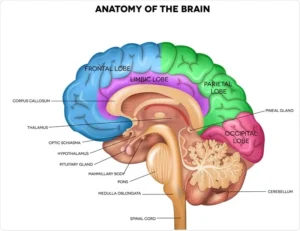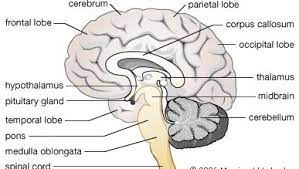11 Fun Facts About Your Brain through Northwestern Medicine
(https://www.nm.org/healthbeat/healthy-tips/11-fun-facts-about-your-brain)
Published October 2019
3 Pounds of Remarkable Matter
“Made up of billions of neurons (or nerve cells) that communicate in trillions of connections called synapses, your brain is one of the most complex and fascinating organs in your body. Keeping your brain healthy and active is vital. Discover just how powerful it is with these interesting facts.
- Sixty percent of the human brain is made of fat. Not only does that make it the fattiest organ in the human body, but these fatty acids are crucial for your brain’s performance. Make sure you’re fueling it appropriately with healthy, brain-boosting nutrients.
- Your brain isn’t fully formed until age 25. Brain development begins from the back of the brain and works its way to the front. Therefore, your frontal lobes, which control planning and reasoning, are the last to strengthen and structure connections.
- Your brain’s storage capacity is considered virtually unlimited. Research suggests the human brain consists of about 86 billion neurons. Each neuron forms connections to other neurons, which could add up to 1 quadrillion (1,000 trillion) connections. Over time, these neurons can combine, increasing storage capacity. However, in Alzheimer’s disease, for example, many neurons can become damaged and stop working, particularly affecting memory.
- Brain information travels up to an impressive 268 miles per hour. When a neuron is stimulated, it generates an electrical impulse that travels from cell to cell. A disruption in this regular processing can cause an epileptic seizure.
- On average, your spinal cord stops growing at 4 years old. Your spinal cord, which consists of a bundle of nervous tissue and support cells, is responsible for sending messages from your brain throughout your body.
- The spinal cord is the main source of communication between the body and the brain. ALS, or amyotrophic lateral sclerosis, causes the neurons in the brain and spinal cord to die, impacting controlled muscle movement. Another disease that affects both the brain and the spinal cord is multiple sclerosis (MS). In MS, the immune system attacks the protective layer that covers nerve fibers, causing communication problems between the brain and the body.
- It’s a myth that you only use 10 percent of your brain. You actually use all of it. (Yes, even when you are sleeping.) Neurologists confirm that your brain is always active.
- The human brain weighs 3 pounds. (That’s about as much as a half-gallon of milk.) However, size does not always imply intelligence. Men tend to have larger brains than women.
- A brain freeze is really a sphenopalatine ganglioneuralgia. This pain occurs when cold hits the receptors in the outer covering of the brain, called the meninges. The cold creates a dilation and contraction of arteries, causing a rapid-onset headache.
- A piece of brain tissue the size of a grain of sand contains 100,000 neurons and 1 billion synapses. However, damage to neurons can have great impact. During a stroke, for example, blood is not able to get oxygen to the brain. As a result, brain cells can die, and abilities in that particular area of the brain can be lost. Similarly, Parkinson’s diseaseoccurs when the cells of a part of your brain called the substantia nigra start to die.
- The human brain can generate about 23 watts of power (enough to power a lightbulb). All that power calls for some much-needed rest. Adequate sleep helps maintain the pathways in your brain. Additionally, sleep deprivation can increase the build-up of a protein in your brain that is linked to Alzheimer’s disease.”

